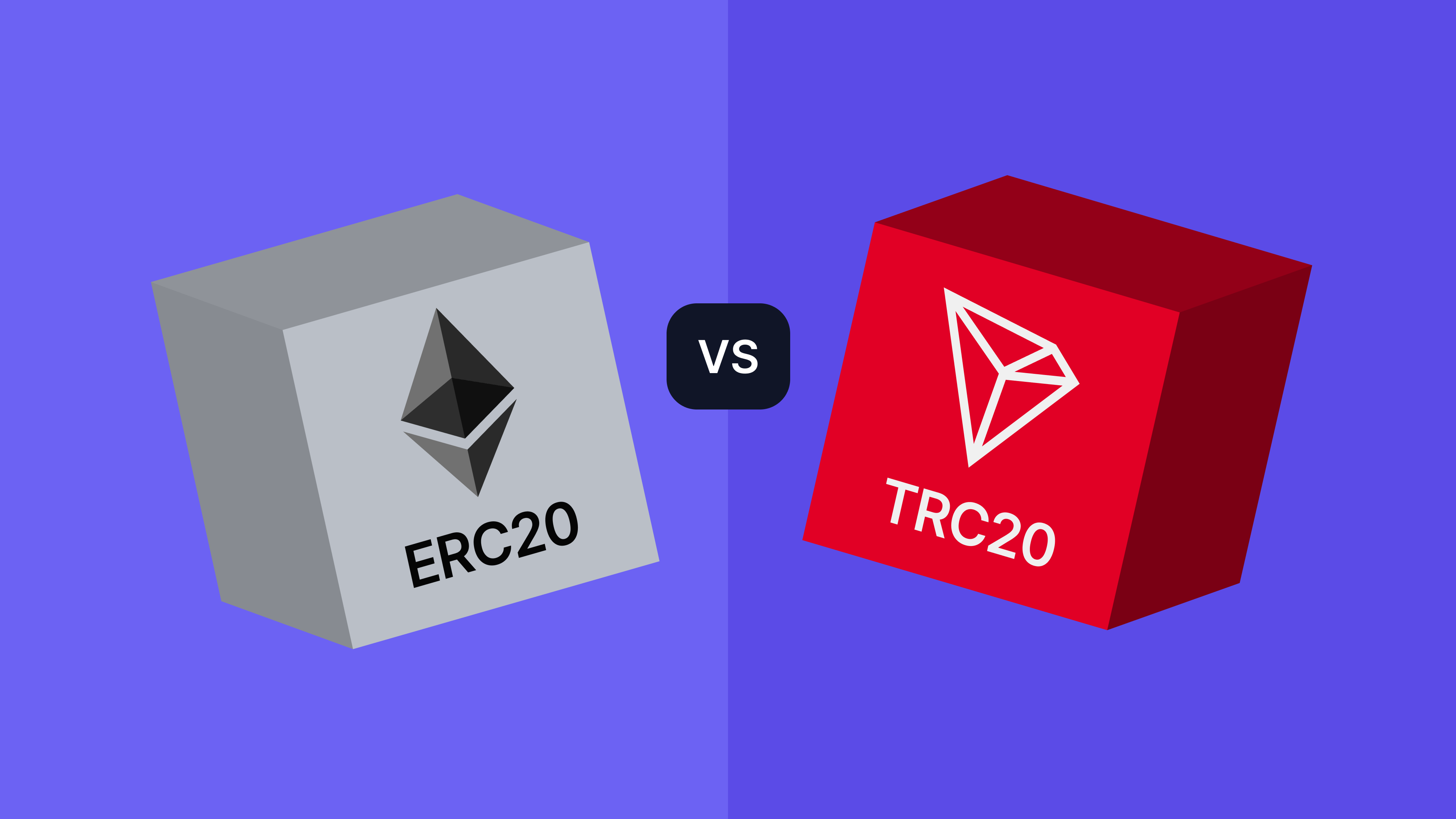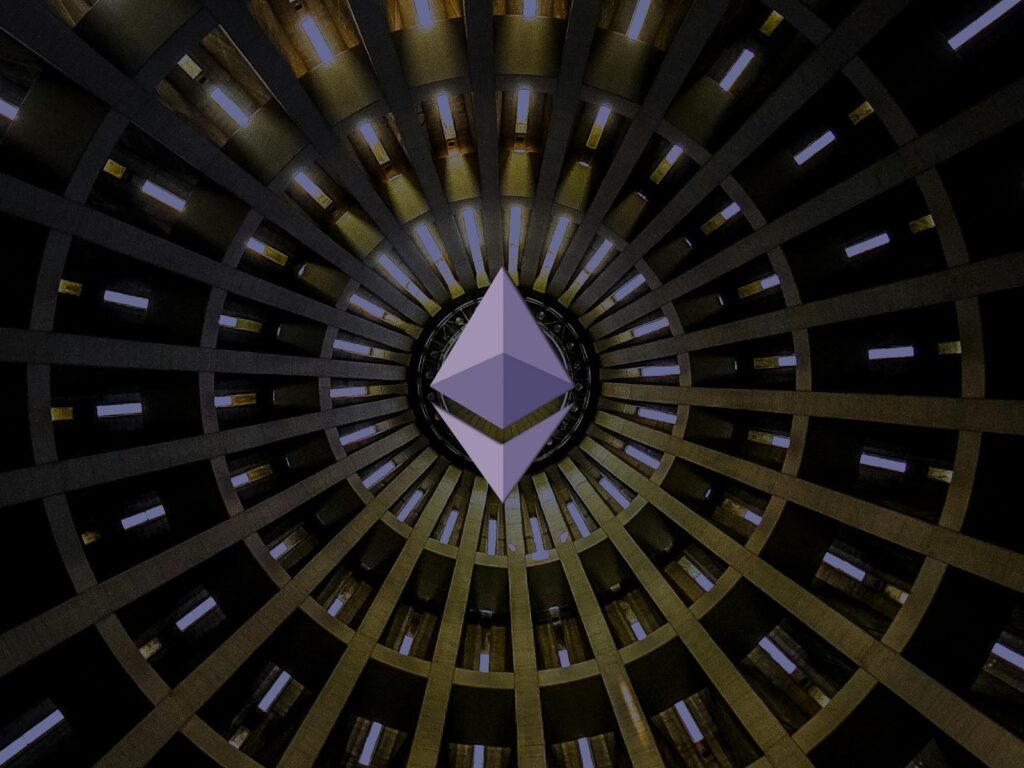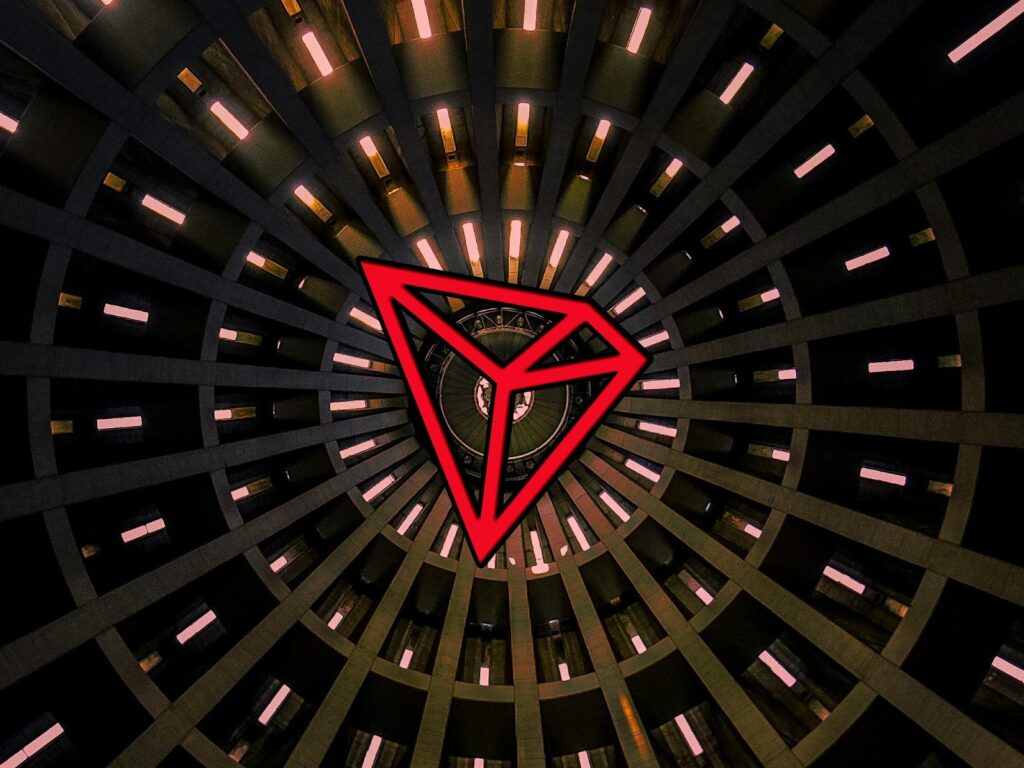
What is the Difference Between TRC20 vs. ERC20

TRC20 and ERC20 are token standards that define how digital assets function on the TRON and Ethereum blockchains, respectively. They outline rules for token creation, transfer methods, wallet compatibility, and interaction with smart contracts, ensuring consistency and interoperability across decentralized applications.
If we compare TRC20 vs ERC20, they are both widely successful standards, powering popular cryptocurrencies and stablecoins, with USD Coin (USDC) being one of the most well-known tokens available on both networks. Still, they have their fair share of differences, impacting factors like transaction speed, security, fees, and adoption.
What is TRC20 and ERC20?
ERC20 and TRC20 are the leading token standards on Ethereum and TRON, defining how digital assets are created, transferred, and interacted with on their respective networks. By establishing a set of rules on how a token is supposed to behave, everyone can get on board and utilize their advantages in Decentralized Finance (DeFI).
We can clearly understand what is ERC20 and TRC20 due to their clear and direct definitions, we can observe the growth of companies and platforms that accept ERC20 and TRC20 crypto payments, because these rules make them trustworthy. Let’s take a closer peek to understand how they get everyone on board.
What is ERC20?

ERC20 is the most widely used Ethereum token standard, providing seamless interoperability across wallets, exchanges, and decentralized applications. It enables efficient token transfers while maintaining security and standardization across the Ethereum network.
The ERC20 standard’s integration provides clear rules for how a token should behave, empowering a broad range of applications, including DeFi, NFTs, and smart contracts, allowing for programmable digital assets. Among ERC20 tokens, we have popular cryptos like USDT, Chainlink (LINK), Uniswap (UNI), and DAI.
ERC20 tokens run on Ethereum and follow a standard set of rules that define how they’re created, transferred, and stored. This ensures they work smoothly across wallets, exchanges, and apps without compatibility issues. Every transaction, whether sending tokens or interacting with smart contracts, requires a gas fee in ETH to process and secure the network.
The best part is that anyone can create a token via a token contract, which defines its rules of use. As of March 2025, there are more than 1.5 million ERC20 token contracts.
Advantages of ERC20
- High security and decentralization. Ethereum’s security model relies on decentralization and the immense difficulty of attacking a large validator network that verifies any movement of ERC20 tokens. Credible validators are randomly selected to propose our transactions as new blocks, and they can lose their staked ETH if they act maliciously, so everyone is incentivized to be fair and maintain security.
- Wide acceptance. ERC20 is supported by many platforms because it’s simple, standardized interface promotes universal compatibility across wallets, exchanges, and apps.
- Strong DeFI and NFT ecosystem. By enforcing a clear set of rules that every token follows, ERC20 has become essential for decentralized finance (DeFi) applications and non-fungible token (NFT) projects.
Disadvantages of ERC20
- High transaction fees (gas fees). Every ERC20 transaction requires gas fees paid in ETH, which fluctuates based on network activity. During periods of high demand, these fees can become expensive, making small or frequent transactions costly for users.
- Slow transaction speeds. Ethereum processes transactions in blocks, and network congestion can lead to delays. ERC20 transactions can take minutes to confirm – not the best option if you need instant payments.
What is TRC20?

TRC20, the TRON’s token standard, prioritizes high-speed, low-cost transactions with TRON-based smart contracts and applications. It facilitates efficient token transfers and decentralized applications (dApps) on the TRON blockchain.
TRON has built a robust ecosystem around gaming, entertainment, and content sharing. TRC20 tokens use TRON’s energy and bandwidth system, significantly reducing transaction costs compared to Ethereum’s gas fees.
Popular TRC20 tokens include USDT, WINk (WIN), BitTorrent (BTT), and JST, and many alternatives that are shared with ERC20 to benefit TRON’s efficient blockchain architecture, resulting in over 175,000 TRC20 token contracts in March 2025.
Advantages of TRC20
- Faster transactions. Instead of relying on random validators, token holders vote to elect a group of 27 Super Representatives (SRs) who are responsible for validating transactions and creating new blocks on the TRON blockchain. This approach enables TRON to achieve remarkable transaction speeds of up to 2,000 transactions per second, far exceeding traditional blockchain networks.
- Lower transaction costs. TRON’s energy and bandwidth model drastically lowers transaction costs, making TRC20 ideal for frequent transfers and microtransactions.
- More efficient for frequent transfers. TRON is built for speed and low costs, making it ideal for frequent transfers. This system allows users to stake TRX to gain energy and bandwidth for multiple transactions without incurring additional costs.
Disadvantages of TRC20
- Less decentralized than Ethereum. TRC20 is less decentralized due to its reliance on just 27 elected Super Representatives to validate transactions and create blocks, raising security and governance concerns
- Lackluster support. TRC20 is not as widely supported on major exchanges and wallets compared to ERC20. Fast transactions are not as useful if you can’t apply them on the platforms that you need.
Is TRC20 cheaper than ERC20?
Comparing ERC20 vs TRC20 fees we see that the transactions are generally cheaper on TRC20.
- Transaction Fees: TRC20 operates on the TRON blockchain, which uses a Delegated Proof of Stake (DPoS) mechanism, resulting in lower transaction fees.
- Speed: TRON processes transactions faster, further reducing costs.
- Gas Fees: ERC20 tokens run on Ethereum, which uses a Proof of Stake (PoS) mechanism. Gas fees can be high, especially during network congestion.
With that said, our direct TRC20 vs ERC20 fees comparison indicates that businesses might lean towards TRC20 for cost-effective and faster transactions.
Key Differences Between TRC20 and ERC20 Tokens
Let’s study and compare the features. Which is better: TRC20 or ERC20 tokens?
| Feature | ERC20 | TRC20 |
| Blockchain Technology | Ethereum’s highly decentralized and secure blockchain | TRON’s scalable and efficient blockchain |
| Transaction Speed | 10-15 minutes (network dependent) | 1-3 minutes |
| Transaction fees | $10–$50 Ethereum’s gas fees. | $1 or less + free daily bandwidth |
| Smart Contract Functionality | Standardized transfers and balance tracking for DeFi protocols and dApps | Limited but growing support for smart contracts |
| Network Compatibility | Widely accepted across crypto exchanges, wallets, and dApps | Mainly used in the TRON ecosystem, less external support |
| Unique coins supported | ~4,990 | ~15 |
Analysing the table: TRC20 vs ERC20, which is better?
ERC20 offers broader compatibility, established security, and extensive DeFi integration but comes with higher fees and slower processing. In contrast of which is better, ERC20 or TRC20, the results are slightly mixed. The latter is faster and more cost-effective but limited to the TRON network with fewer supported tokens and less smart contract functionality.
How to Verify ERC20 and TRC20 Token Standards
Users can verify if their tokens follow ERC20 or TRC20 standards by checking the token’s contract on blockchain explorers like Etherscan or Tronscan to make sure it implements their required functions and behavior.
Checking Wallet Address Format
Each blockchain network will generate a separate address for you, so even if you have a multi-chain wallet that supports both, each standard will have a different address.
ERC20 wallet addresses start with 0x plus 40 hexadecimal characters, for example: 0x89205A654248D3A7bF3C1624337222968……..
TRON addresses start with a letter “T”: TWzXKKZwVHtW9Rq3uM3w3pV9R6U……..
Checking on Crypto Wallets & Exchanges

Understanding your resources on a multi-chain wallet can be confusing. For example, how do I know if my USDT is ERC20 or TRC20? Most wallets and exchanges indicate the token standard. To be safe, copy the token’s contract address from your wallet and check it on the mentioned blockchain explorers. Double-check before sending, as transactions to incompatible networks result in permanent loss of funds.
Which One Should You Use for Your Business Payments?
But what is the difference between TRC20 and ERC20, and which one should you use for business payments? While the best answer would be both, understanding their differences should help you switch between standards depending on the use cases.
TRC20 is a better option for fast and low-cost transactions for trading or frequent transfers. TRON’s focus on speed and efficiency makes it a great option for applications like decentralized exchanges (DEXs) and gaming dApps. However, it has less support for complex DeFi platforms compared to Ethereum, which limits its use in lending, borrowing, and other advanced financial services.
However, ERC20 provides a robust DeFi ecosystem, with numerous platforms offering complex financial services from which businesses benefit more. Their priority for security opens up more opportunities for borrowing and investment.
Top 10 ERC20 and TRC20 Cryptocurrencies
While token standards define compatibility and security, that’s not everything, otherwise, we would not have so many cryptos. The differences in token contracts also affect their governance mechanisms, community support, use cases, and popularity. Let’s look at the top 10 cryptocurrencies for ERC20 and TRC20.
Top 10 ERC20 Tokens
- Tether (USDT). The biggest stablecoin pegged to the US dollar is constantly used as a base or quote currency in trades, cross-border payments, and remittances.
- USD Coin (USDC). Another US dollar-pegged stablecoin backed by audited reserves, operating under strict regulatory oversight, as its legitimacy results in a growing number of platforms that accept USD Coin payments.
- Lido Staked Ether (stETH). Represents staked Ether in the Lido protocol, allowing holders to earn staking rewards while maintaining liquidity – a passive income without locking funds.
- Shiba Inu (SHIB). A unicorn among meme-inspired cryptos, this ERC20 token just kept growing in popularity. With surprisingly extensive community support, now we have many services that acccept SHIB payments.
- Wrapped Bitcoin (WBTC). Unlike native Bitcoin, WBTC combines the liquidity of BTC with the ability to access lending, borrowing, and yield farming without leaving Ethereum’s DeFi ecosystem.
- Chainlink (LINK). LINK is the native token of Chainlink, a decentralized oracle network that allows smart contracts to access real-world data, making it easy to integrate into platforms that need accurate external information
- Uniswap (UNI). The governance token for the Uniswap decentralized exchange, holding UNI gives you a direct say in Uniswap’s future, allowing you to vote on key decisions like fee structures, liquidity incentives, and new feature implementations.
- Polygon (MATIC): MATIC is unique in its widespread adoption, offering businesses fast, low-cost transactions without sacrificing Ethereum’s security, resulting in the growth of services that accept MATIC payments
- Dai (DAI). A decentralized stablecoin that maintains its value relative to the US dollar through an automated system of smart contracts. Because it is a digital currency without the risks associated with centralized control, now we have more platforms that accept DAI payments.
- Wrapped Ether (WETH): Unlike standard ETH, which is the native currency for the entire blockchain, WETH follows the ERC20 format, making it compatible with DeFi applications and decentralized exchanges.
Top 10 TRC20 Tokens
- TRON (TRX). The core of the TRON blockchain, TRX is used for transaction fees, staking, and governance. TRX enables nearly fee-less transactions thanks to TRON’s bandwidth and energy system, and there are platforms that accept TRON payments.
- Tether (USDT). Also available as a TRC20 token, this USDT version is preferred by traders and businesses that want ultra-low fees and fast transactions.
- USD Coin (USDC). A stablecoin available on TRON, providing a reliable medium of exchange pegged to the US dollar for quick payments and trading.
- BitTorrent (BTT). A token that incentivizes decentralized file sharing, BTT rewards users who share bandwidth and storage on the BitTorrent network and speeds up downloads.
- JUST (JST). The governance token for the JUST DeFi platform, JST allows users to vote on protocol changes and participate in decentralized lending and stablecoin issuance.
- WINk (WIN). A token used within the WINk gaming platform, WIN is a growing currency for placing bets, earning rewards, and participating in decentralized gambling while maintaining transparency.
- Sun Token (SUN). A social experiment token within the TRON ecosystem, often associated with governance and staking. Unlike most governance tokens, SUN also plays a role in liquidity mining and yield farming.
- APENFT (NFT). A token representing shares in art pieces and NFTs, APENFT represents ownership stakes in digital and real-world art.
- Klever (KLV). A utility token for the Klever ecosystem KLV is used for transactions, staking, and accessing blockchain services within Klever’s wallet and exchange.
- TRONpad (TRONPAD). Enables fundraising for new projects on the TRON network, allowing investors to access early-stage blockchain startups.
ERC20 vs TRC20 FAQs
If you’re still wondering what is ERC20 and TRC20 or how they differ, keep reading the FAQs to find more information.
Is ERC20 the same as TRC20?
ERC20 and TRC20 may seem similar, but they operate on different blockchains and have distinct features.
Which platforms support ERC20 and TRC20?
Most crypto exchanges, wallets, and DeFi platforms support both ERC20 and TRC20. However, ERC20 has wider integration in the global crypto ecosystem and more use cases for businesses.
How long does a transaction take on ERC20 vs. TRC20?
ERC20 transactions can take around 1-5 minutes due to its system of validators and depending on network congestion. TRC20 transactions typically settle within a few seconds.
Which is better, TRC20 or ERC20?
Which token is better depends on your use case. TRC20 is better for fast, low-cost transfers, while ERC20 offers stronger security and greater adoption
How to check if USDT is ERC20 or TRC20?
To check which token standard is used for your USDT, look at the deposit address. ERC20 starts with “0x,” while TRC20 starts with “T.” Double-check this information in your wallet or exchange settings.
Can TRC20 be transferred to an ERC20 wallet?
No, do not attempt such transfers under any circumstances! Sending TRC20 to an ERC20 wallet can cause a permanent loss of your crypto funds.
Why traders prefer TRC20?
While both standards handle token transfers, the TRC20 and ERC20 difference lies in their underlying blockchains — TRC20 uses TRON, which is more cost-effective and faster than ERC20, which is why traders favor TRC20.
Ready to Make the Right Choice?
It is not fair to judge both token standards on equal footing as they serve different purposes. ERC20 is all about security and widespread integration with DeFi and NFT platforms. These features make it a preferred choice for businesses that rely on stability and access to established systems. Meanwhile, TRC20 provides a fast and cost-effective alternative, ideal for frequent transactions and micro-payments, where speed is a top priority, though it doesn’t provide access to the same platforms as ERC20.
For a diverse crypto strategy, we suggest partnerships with payment processors that handle both token standards, so you don’t need to worry about the difference between ERC20 and TRC20. Instead, just use them both! With the help of our crypto payment gateway, there’s no need to worry about differences in standards when you can get the best of both worlds.
Got any questions? Contact us for more info on crypto solutions or sign up today and let’s get to work on integrating crypto payments!
Accept crypto with CoinGate
Accept crypto with confidence using everything you need in one platform.

